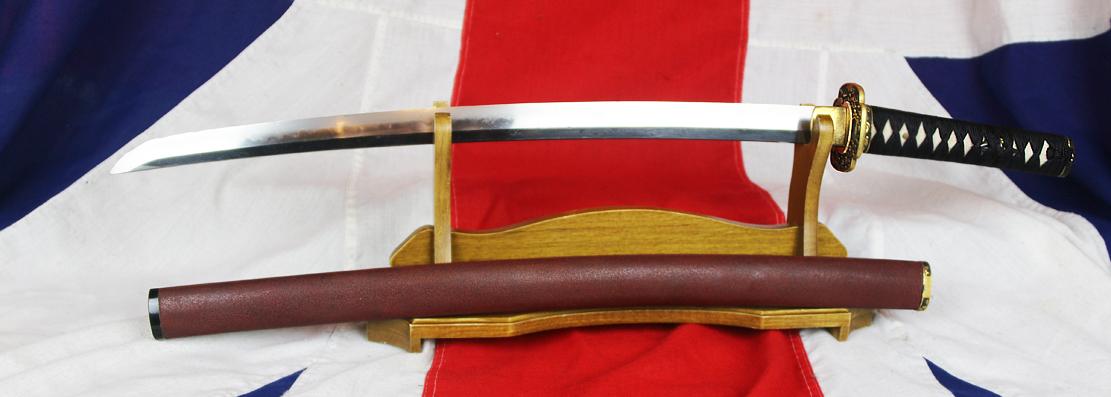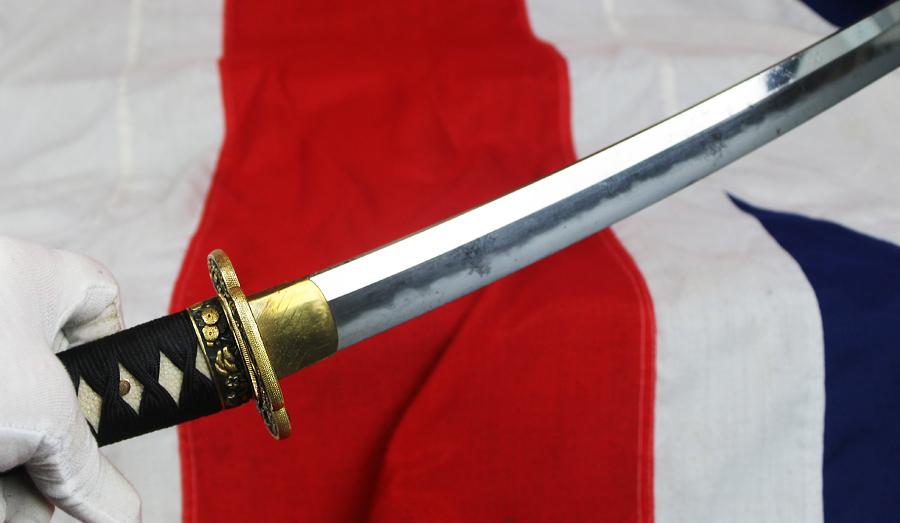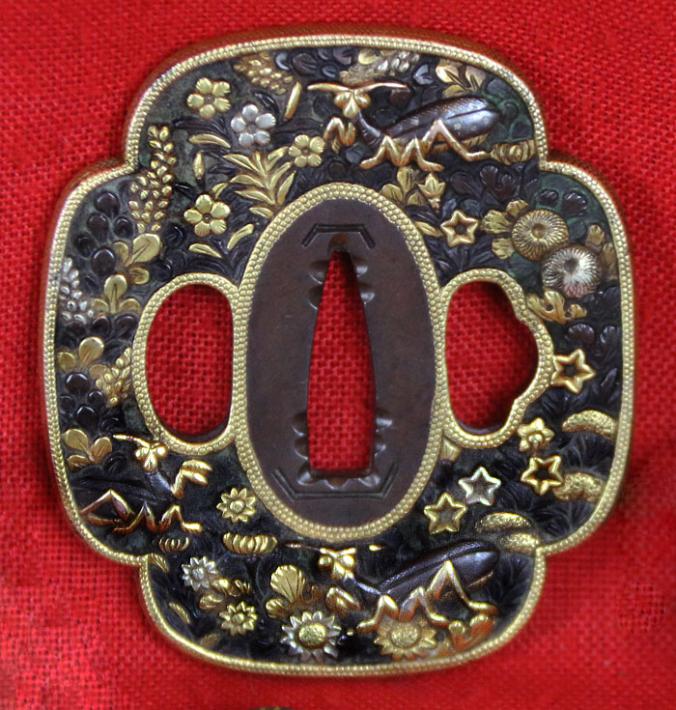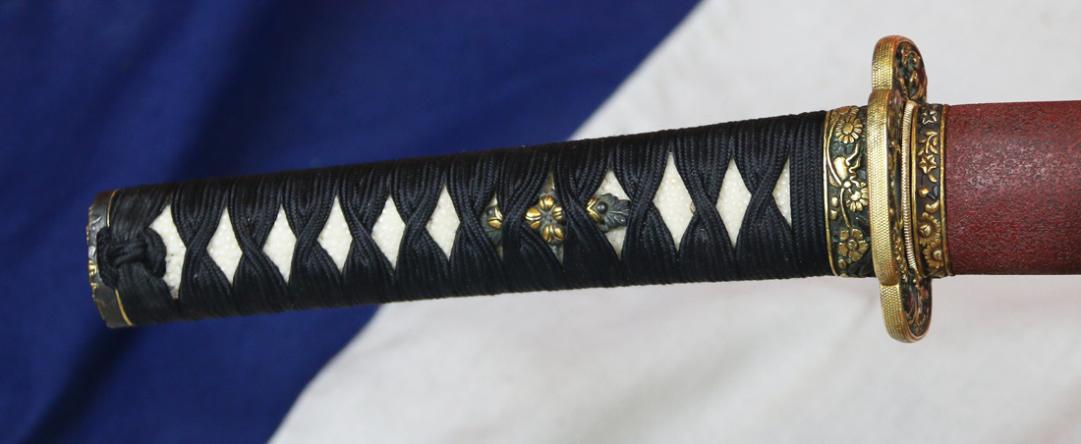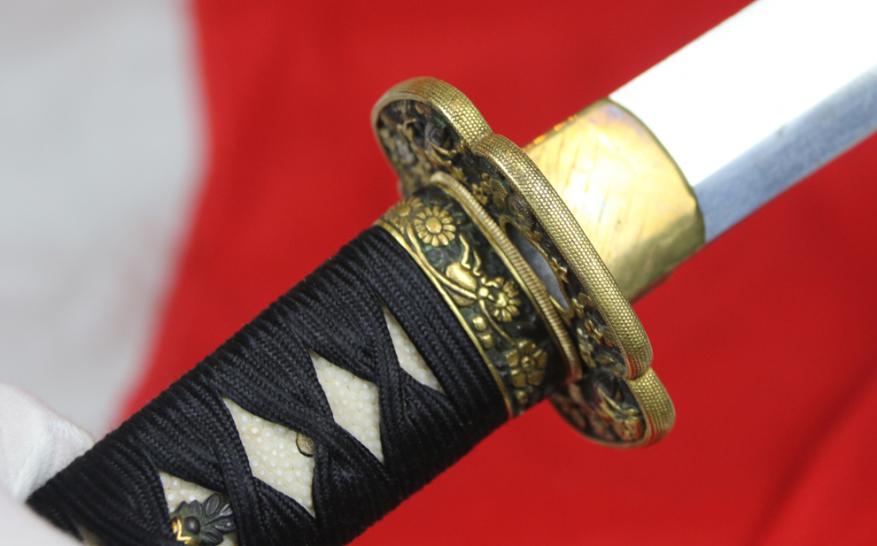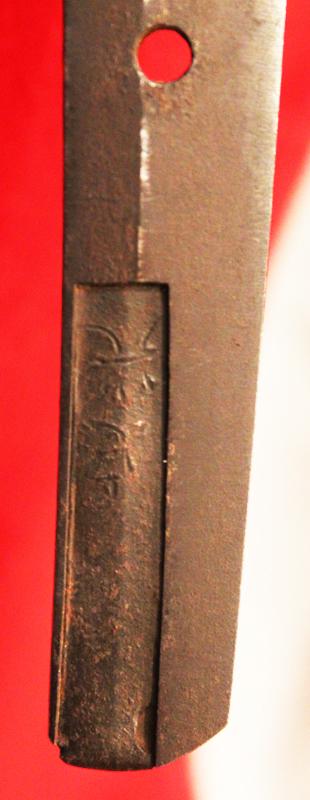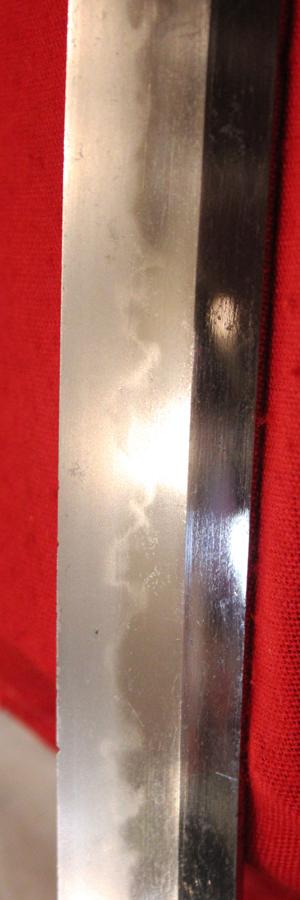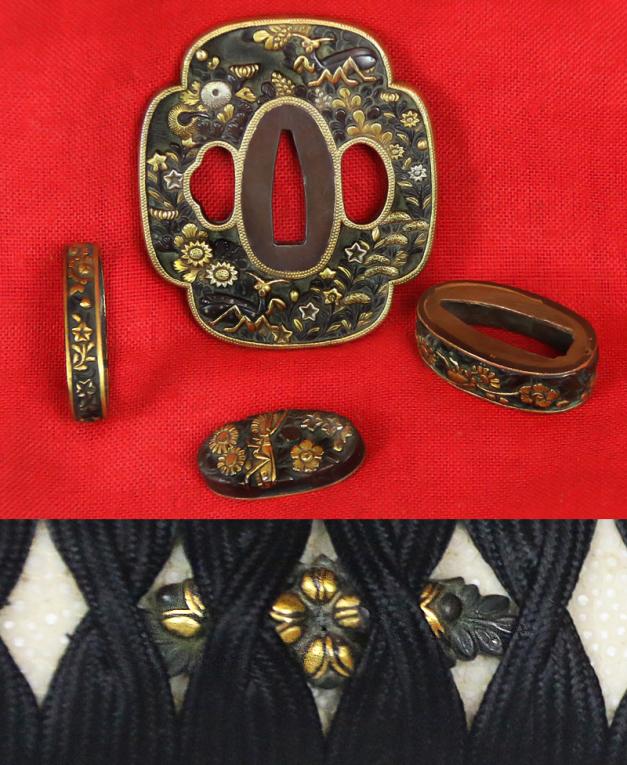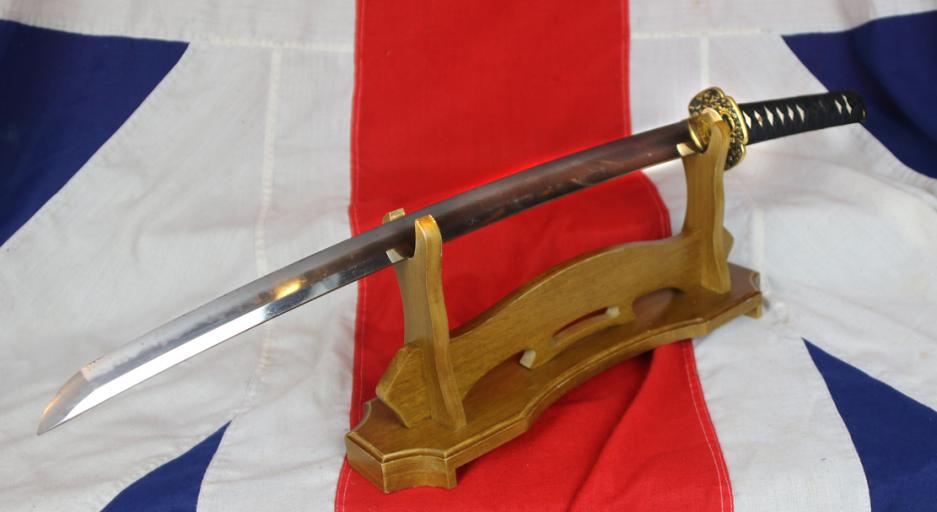A Fabulous Museum Grade Samurai Daimyo's Art-Sword. From The Koto Era. A Samurai Wakizashi Sword By Master Tadamitsu With Rare Gaku-mei Nakago. Blade, Circa 1440-1460. Mino Goto Koshirae, With Deep Red Ishime Lacquer Saya & Black Silk Binding
With very rare gaku-mei framed nakago, where the mei (signature) was moved from this original nakago tang, and inserted into the shortened tang, and framed in order to preserve the important master smith’s signature, upon his museum grade blade. Overall this stunning art-sword is in incredible near flawless condition. The term art-sword refers that highest grade of samurai sword, that was certainly made for all forms of combat use, yet are decorated with such beauty and skill that they are as much works of art as a samurai's combat arm. Likely made for for the highest ranking samurai or daimyo clan lord.
With its spectacular suite of beautiful, original, Edo period Mino-Goto fittings, with tsuba, in shakudo, and uttori of pure gold decor of flowers, cricket, catydid and praying mantis. Deep red ishime urushi stone finish lacquered saya, with carved buffalo horn fittings and a Mino-Goto throat mount.
Superb black silk tsuka-ito over fine pure gold decorated menuki.
A wonderful Muromachi era blade almost 600 years old, with a superb, incredibly active hamon, in a beautiful polish with gold foil habaki and blade smith shortened tang with its original preserved ‘folded over’ signature inlaid and inserted within the tang.
The hamon forms a delightful gunome pattern, mixing with clove (Choji) outline which is slanted generally. The founder of the sword maker school, Tadamitsu in Bizen, is referred in the Shouou period (1288-93) and the oldest existent Tanto by him has the date year, Teiji 3,1364) during the Nanbokucho period, then later generations shows the records of Ouei to Bunmei era (1394-1486) in Muromachi period. The preserved 'folded over' system, that can be seen beautifully done on this blade, in order to preserve the blade smith's signature, was only reserved for the best and most highly revered blades, often of historical significance to the samurai's family. The ancient province of Kibi (of which Bizen was the easternmost region; now Okayama prefecture) possessed excellent ironmaking technology, which helped make Kibi into a powerful state. The region is blessed with all the vital ingredients needed for Japanese sword making: iron sand, water, and charcoal of Japanese red pine, which has excellent thermal efficiency. Research on Japanese swords since the Meiji period has revealed five different features or styles based on the regions in which they were made: Yamashiro (Kyoto prefecture), Yamato (Nara prefecture), Bizen (Okayama prefecture), Sagami (Kanagawa prefecture), and Mino (Gifu prefecture. The characteristic styles of these five regions were passed down from master to disciple and from one region to the next. These are collectively known as Gokaden (five traditions of swordmaking). The province of Bizen was located far from Japan's political center throughout its history, allowing it to prosper regardless of the political state of sovereignty of the day. The most typical Bizen blade has a steel surface grain called itamehada (wooden board grained) with a unique pattern called chōji (clove-shaped) on the blade. This pattern is a feature of Bizen swords and it is what makes Bizen swords special.
The Gotō School of sword-fittings makers was founded in the fifteenth century by Gotō Yūjō, who is said to have been patronized by the shogun Ashikaga Yoshimasa (1435–1490). The work of the Gotō masters is characterized by painterly designs carved in high relief on a ground of shakudō (an alloy of copper and gold chemically treated to turn a rich blue-black), finished in nanako (tiny circles punched regularly over the surface to give it a granular appearance) with colorful accents in gold and silver. The succeeding generations of Gotō masters continued to work in these soft metals and concentrated on the smaller sword fittings, such as kozuka (the handle of the small utility knife fitted into a slot on some swords, on the the back of a sword’s saya or scabbard), kōgai (a skewer-like hairdressing tool carried in the front of the scabbard), and menuki (a pair of grip ornaments secured by the handle wrappings). The production of the stouter sword guards, or tsuba, was left to other masters. While earlier generations had not signed their work, some Gotō masters in about 1600 began to authenticate the work of their predecessors; the attributions usually were engraved on the backs of the pieces themselves. These attributions bear testimony to the keen interest in early sword fittings as status symbols for high-ranking samurai.
Fuchi kashira,menuki and tsuba from the Mino School. Sometimes known as an offshoot from the Goto School, the Mino tradition of kinko have their roots from the Koto period, Known as Ko-Mino, that style led to the Edo Mino tradition which used the difficult technique of Uttori, or gold foiling. The gold on these stunning pieces are not plated, but rather have generous hammered gold foil applied in a very difficult technique not seen today except in habaki work. Because it was so time consuming and difficult, there are relatively few works by this school. Design is very traditional of kiku (chrysanthemums) and flowering blossoms and leaves, with catydids and praying mantis etc. and is executed very well indeed.
As once told to us by an esteemed regular visitor to us here in our gallery, and the same words that are repeated in his book;
“In these textures lies an extraordinary and unique feature of the sword - the steel itself possesses an intrinsic beauty. The Japanese sword has been appreciated as an art object since its perfection some time during the tenth century AD. Fine swords have been more highly prized than lands or riches, those of superior quality being handed down from generation to generation. In fact, many well-documented swords, whose blades are signed by their makers, survive from nearly a thousand years ago. Recognizable features of the blades of hundreds of schools of sword-making have been punctiliously recorded, and the study of the sword is a guide to the flow of Japanese history.”
Victor Harris
Curator, Assistant Keeper and then Keeper (1998-2003) of the Department of Japanese Antiquities at the British Museum. He studied from 1968-71 under Sato Kenzan, Tokyo National Museum and Society for the Preservation of Japanese Swords
As once told to us by an esteemed regular visitor to us here in our gallery, and the same words that are repeated in his book;
“In these textures lies an extraordinary and unique feature of the sword - the steel itself possesses an intrinsic beauty. The Japanese sword has been appreciated as an art object since its perfection some time during the tenth century AD. Fine swords have been more highly prized than lands or riches, those of superior quality being handed down from generation to generation. In fact, many well-documented swords, whose blades are signed by their makers, survive from nearly a thousand years ago. Recognizable features of the blades of hundreds of schools of sword-making have been punctiliously recorded, and the study of the sword is a guide to the flow of Japanese history.”
Victor Harris
Curator, Assistant Keeper and then Keeper (1998-2003) of the Department of Japanese Antiquities at the British Museum. He studied from 1968-71 under Sato Kenzan, Tokyo National Museum and Society for the Preservation of Japanese Swords
Overall blade length from base of habaki to tip 21.5 inches long.
Code: 23519
11995.00 GBP


